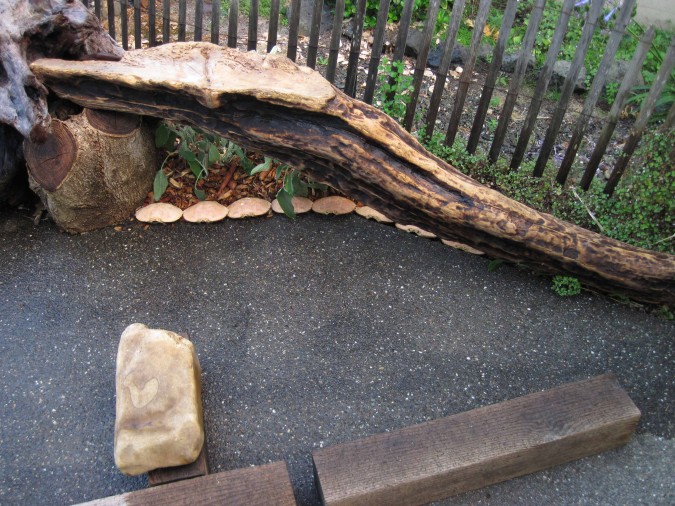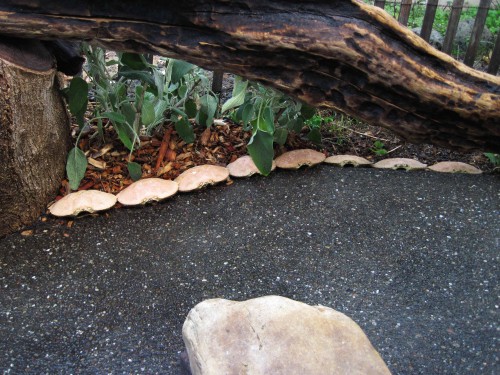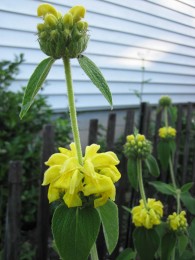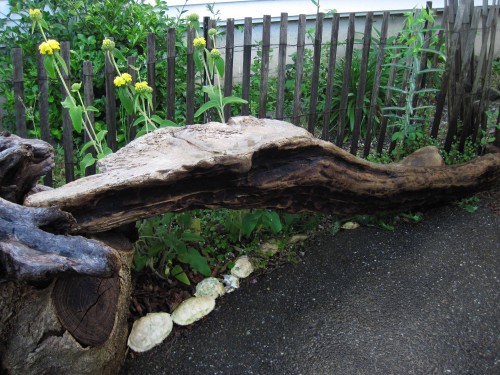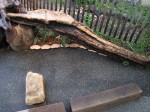
Carabid Carapace Cabanas was about planting Jerusalem sage in the thin strip of poor soil between our driveway and the property line fence. Our neighbors want low maintenance. We want a thriving animal habitat, food forest, critter wonderland. Tall order for a 12″-wide strip of soil, destined to be a low-water hydrozone. We had the plants — the Jerusalem sage was from a pruning debris (debris, HA!!!) pile on street in front of a local park. Got to do somethin’ with this plant.
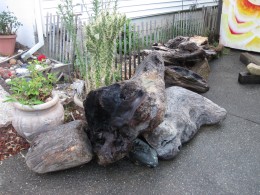
Area for planting, habitat installation -- the Before. Note the intentional low-water zone with cacti, potted plants, and tree "boulders".
The Jerusalem sage had been freshly pruned and was fairly vibrant, full of life. I knew that it was a fairly drought-tolerant plant, so I wanted to get it established now in some organic mass, only to be able to leave it be in future years. I had some wood chips on hand from a local arborist friend (thank you, Tom!); they would work well to mulch the area. I scraped out , loosened the topmost layer of crud (you call this soil?!) and worked the sage cuttings down a couple of inches. The cuttings came from a large bush, perhaps 6-8 feet wide at the base. They were about 3 feet long — a long flat curve for at least 18″, then swept up. What a hassle to plant these cuttings with a 90 degree bend in them. Orrrrrrrrrrrr, how lucky am I? Yes, the right-angle-shaped cuttings were perfect for starting these cuttings.
Because the Jerusalem Sage cuttings were to be transplanted at the end of our dry season, they needed every possible advantage to create roots and thrive. Being able to horizontally plant the first 18″ of the cuttings under moist mulch was such an advantage. So be it — the cuttings were scratched in, the stalk ends were positioned pointing skyward, and mulch was used to snug them into place. But I want MORE MULCH. How rockin’ is this project?! More finally gets to be better!
And, in order to get more wood chips and surrounding oh-so-natural duff on top of the unstable sage stalks, I will want something to build up along the driveway, a higher edge to be able to pile up the mulch. Thinking. Thinking, still. Yes! Those dungeness crab carapaces that I have been drying on top of the refrigerator are finally going to make it into the garden. All those come-and-get-it calcium and sea mineral-rich shells have finally qualified for an animal project, an animal habitat. “Habitat?”, you ask.
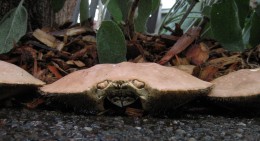
We have left for the day. Please leave any packages with our neighbor, Mrs. Pill(bug), at carapace number 3. (The Beetles)
This installation, Carabid Carapace Cabanas, is not merely about planting, saving, giving a new lease on Life to some forgotten Jerusalem sage plants. We (I love to include innocent people) have jumped to Art in the Garden. Sea Life in the garden. Cool looking, I-want-a-car-like-that looking, scary-even-when-dead looking gifts from Nature! There must be some hint of an animal habitat here somewhere.
Of course! Critters will live, thrive, make house, set up neighborhood in the crab shells. Here we go, then. The carapaces are lined up along the edge of the driveway next to the cuttings’ planting area. More mulch and wood chips are worked around the sage stalks and up against the crab shells. The carapaces/shells are hunkered down into their embankment, albeit only an inch or two high, of mulch/chips. We got our MORE organic matter around the stalks, onto the planting area. That much more nutrients and moisture will be available for the sage cuttings. Peace on Earth sings loudly.
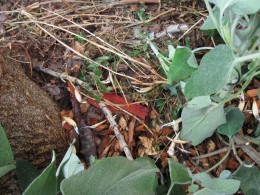
Wood chips hold the Jerusalem sage cuttings in place. Duff gathered from the immediate surroundings soften the just-planted look AND provide an inoculation of microbes for the new planting.
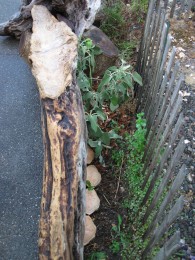
Planting of the Jerusalem sage is complete. Note how thin the strip of available planting space is and how the neighbors' yard is about growing pea gravel. The drought tolerant sage was grown on our side of the fence to minimize water on their side of the fence. More water = more weeds, and we don't wish that for our neighbors wanting low-maintenance.
The planting bed, that is, the mulch and wood chips and sage cuttings, were kept moist for a couple of weeks. And the cuttings made it! They lived happily ever after in their little corner of the driveway. The wet winter season was a boon for the newly developing roots.
By spring, the plants were vibrant and boasting blooms.
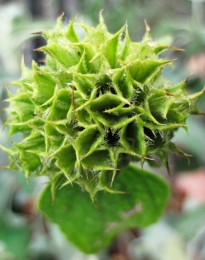
Jerusalem sage flowerhead without petals. This spring vibrant green flowerhead will become a dry brown cluster of seeds come summer.
And the blooms kept coming. Very nice that by spring and early summer, this transplant was so obviously thriving. But then, tragedy.
I walked out the front door one day to find the row of cabanas had been DISTURBED! What is this?! Whooooooo did this?! What has the culprit done to our fine art project? (You should be upset, too.) Oh, how disappointing.
A breath. Another breath. A glimmer of light coming. Possible okayness working its way into my carapace of a brain. A quick swirl of positive possibility. Sure. Why not? This could be a good thing.
That was close. I nearly forgot why we had installed this animal habitat in the first place — to attract critters and give them a place to thrive in. And now we have it; we have success. There are messy, slimy, uncouth critters here on our driveway, in the smack middle of suburbia. How great!
Last night’s critter was looking for food. That very smart critter was looking through the line of cabanas because it knew that insects and mollusks (slugs and snails) live in the cabanas. My bet is that the dinning critter got some meal because of the extensive disruption of the crab shells. And, the diner left us a gift.
Every time a critter visits your garden, it leaves a trace of microbes. That’s good critter etiquette. And those gifted microbes will introduce themselves (microbe etiquette) to the fauna also, previously, in your garden. And there will be biodiversity, and there will be happiness throughout the land.
Tony

